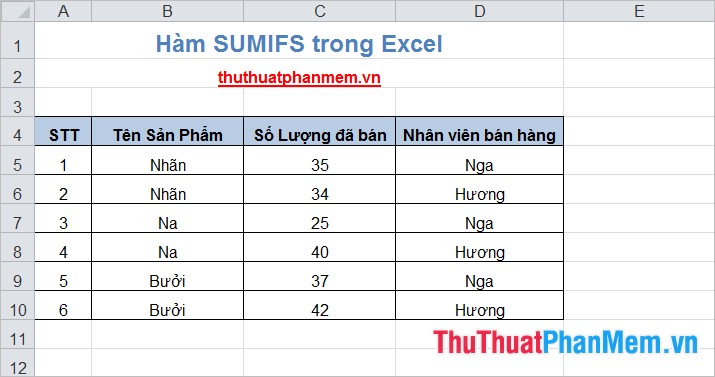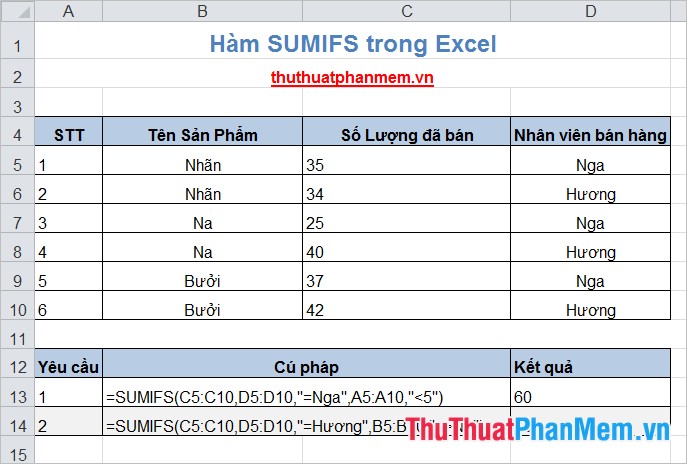SUMIFS function in Excel
You already know how to sum in Excel with the SUM () function, but to sum cells that satisfy many given conditions, you may not know it. The SUMIFS () function helps you quickly sum cells in a range that satisfy one or more conditions.

The following article will describe the syntax, functions, and usage of the SUMIFS () function in Excel.
Description
The SUMIFS () function is a function that sums cells in a range, the selection range meets one or more conditions.
Syntax
= SUMIFS (sum_range, criteria_range1, criteria1, criteria_range2, criteria2, .)
Inside:
- sum_range: is the cells to sum including numbers or names, ranges or cell references containing numbers, blank values and text values are ignored. Is required parameters.
- criteria_range1: range to be evaluated by conditions, required.
- criteria1: condition in the form of a number, expression, cell reference, required.
- criteria_range2, criteria2, .: optional additional ranges and conditions, the function allows up to 127 pairs of criteria_range, criteria.
Note
- For each cell in the range, the sum_range range will be summed when all the conditions specified are true for that cell.
- The cells in sum_range containing TRUE are considered to be 1, cells that are not yet FALSE are considered as 0.
- Each criteria_range must have the same size and shape as sum_range, ie criteria_range and sum_range must have the same number of rows and the same number of columns.
- In criteria criteria, you can use wildcards: a question mark (?) Instead of a single character, asterisk (*) instead of a certain string. If the condition is a question mark or asterisk, you must enter an additional ~ before it.
For example
Given the following data sheet:

Request:
1. Calculate the total number of products sold by employees named Russia with No. <5.
2. Calculate the total number of products sold by the employee named Huong with all products except "Na".
The results after applying the SUMIFS () function are as follows:

So, with the content of this article presented, you can know the syntax, functions and how to use the SUMIFS () function through specific examples. Hope the article will help you. Good luck!
You should read it
- Differentiate between SUM, SUMIF, SUMIFS and DSUM functions
- SUMIF and SUMIFS functions - specific usage and examples
- How to calculate the total value based on multiple conditions in Excel
- Basic Excel functions that anyone must know
- How to use Hlookup function on Excel
- How to use the SUM function to calculate totals in Excel
- How to use the LEN function in Excel
- How to use COUNTIF function on Excel
May be interested
- How to use the MOD function and QUOTIENT function in Excel
 injury in excel has many ways of doing it, can be used manually or using the calculation function.
injury in excel has many ways of doing it, can be used manually or using the calculation function. - 8 little-known Excel functions that can save you a lot of work
 even seasoned excel users often find themselves stuck performing tasks manually that could be automated with a few clever functions.
even seasoned excel users often find themselves stuck performing tasks manually that could be automated with a few clever functions. - How to use MID functions to get strings in Excel
 mid function in excel is a function that takes the middle character string corresponding to the value that the user requires to perform.
mid function in excel is a function that takes the middle character string corresponding to the value that the user requires to perform. - How to use Excel's VALUE function
 excel's value function will convert a string to a digital form, which can be combined with other functions such as left function, right function, mid function.
excel's value function will convert a string to a digital form, which can be combined with other functions such as left function, right function, mid function. - How to use the WRAPROWS function in Excel
 having trouble with handling large data sets in excel? then learn how to use the wraprows function to split them into more manageable rows.
having trouble with handling large data sets in excel? then learn how to use the wraprows function to split them into more manageable rows. - How to use the IFS function in Excel 2016
 the ifs function in excel is a logical function introduced in excel 2016. this function is a function that replaces the nested if function and is much easier to use. the ifs function checks one or more conditions and returns a value that meets the first true condition.
the ifs function in excel is a logical function introduced in excel 2016. this function is a function that replaces the nested if function and is much easier to use. the ifs function checks one or more conditions and returns a value that meets the first true condition. - How to use the NPER function in Excel to plan loans and savings
 do you want to effectively manage and control your personal finances? then we invite you to learn how to use excel's nper function.
do you want to effectively manage and control your personal finances? then we invite you to learn how to use excel's nper function. - How to use the function to delete spaces in Excel
 deleting white space with functions in excel makes it easier for users to handle content, instead of traditional editing.
deleting white space with functions in excel makes it easier for users to handle content, instead of traditional editing. - How to fix the SUM function doesn't add up in Excel
 in the process of summing with sum in excel, you will encounter some errors such as not jumping the number, not adding the sum. so how to handle this problem?
in the process of summing with sum in excel, you will encounter some errors such as not jumping the number, not adding the sum. so how to handle this problem? - How to use the SUBTOTAL function in Excel
 the subtotal function in excel is used in many different cases, helping you to sum subtotals in a list or database, unlike the sum function in excel such as counting cells, calculating average, finding the largest / smallest value. or sum the filtered list values in excel
the subtotal function in excel is used in many different cases, helping you to sum subtotals in a list or database, unlike the sum function in excel such as counting cells, calculating average, finding the largest / smallest value. or sum the filtered list values in excel










 The LOWER, UPPER and PROPER case-conversion functions in Excel
The LOWER, UPPER and PROPER case-conversion functions in Excel DATE function - The date function in Excel
DATE function - The date function in Excel MINA and MAXA functions in Excel
MINA and MAXA functions in Excel The SQRT function returns the square root of a positive number in Excel
The SQRT function returns the square root of a positive number in Excel The VALUE function converts a numeric string to a number format in Excel
The VALUE function converts a numeric string to a number format in Excel MID and MIDB functions to cut strings in Excel
MID and MIDB functions to cut strings in Excel